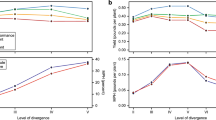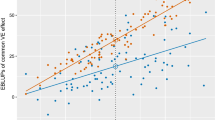Summary
Consideration was given to the response curves and response surfaces that are obtained when genotypes are grown at various levels of environmental factors. These curves and surfaces were used to illustrate genotype-environment interactions and possible relations between two parents and their F 1.
When a hybrid had a response exactly intermediate between its parents, the metric values for the hybrid were not intermediate but varied with the environment, exhibiting different degrees of dominance including overdominance (hybrid vigour). A range in dominance for the metric also was found when the response of the hybrid was more similar to one parent than the other.
A hybrid with an intermediate response has a lower phenotypic variance across environments than the mean variance of its parents. In some situations the hybrid's variance is less than that of either parent.
A component of the error variation for a genotype was shown to vary with the environment having a minimal value when the environment was optimal.
An algebraic treatment of response curves and surfaces was presented. In some instances the metric values for two parents and their F 1 in a range of environments may be related in the form of a multiple regression.
Similar content being viewed by others
Literature
Antonovics, J., Lovett, J., Bradshaw, A.: The evolution of adaption to nutritional factors in populations of herbage plants. FAO-IAEA Proc. Ser. Symp. on Isotopes in Plant Nutrition and Physiology, Vienna 1966 (1967).
Box, G.: The exploration and exploitation of response surfaces: some general considerations and examples. Biometrics 10, 16–60 (1954).
Bucio Alanis, L.: Environmental and genotype-environmental components of variability. I. Inbred lines. Heredity 21, 387–397 (1966).
Bucio Alanis, L., Hill, J.: Environmental and genotype-environmental components of variability. II. Heterozygotes. Heredity 21, 399–405 (1966).
Colyer, D., Kroth, E.: Corn yield response and economic optima for nitrogen treatments and plant population over a seven year period. Agron. J. 60, 524–629 (1968).
Dillon, J.: The analysis of response in crop and livestock production. Oxford: Pergamon Press 1968.
Goodall, D., Grant Lipp, A., Slater, W.: Nutrient interactions and deficiency diagnosis in the lettuce. I. Nutritional interaction and growth. Aust. J. Biol. Sci. 8, 301–329 (1955).
Griffing, B., Langridge, J.: Phenotypic stability of growth in the self-fertilised species Arabidopsis thaliana. In: Statistical Genetics and Plant Breeding NAS-NRC 368–390 (1963).
Gustafsson, A., Dormling, I.: Dominance and overdominance in Phytotron analysis of monohybrid barley. Hereditas 70, 185–216 (1972).
Hackett, C.: Balance between potassium and phosphorus in the nutrition of barley. II. Observations on growth and uptake. Ann. Bot. NS 30, 321–327 (1966).
Haldane, J.: The interaction of nature and nature. Ann. Eugen. 13, 197–205 (1947).
Heady, E., Dillon, J.: Agricultural Production Functions. Ames, Iowa: Iowa State University Press 1961.
Knight, R.: The measurement and interpretation of genotype-environment interaction. Euphytica 19, 225 to 235 (1970).
Knight, R.: A multiple regression analysis of hybrid vigour in single crosses of Dactylis glomeraia L. Theoret. Appl. Genet. 41, 306–311 (1971).
Lewis, D.: Gene-environment interaction: A relationship between dominance, heterosis, phenotypic stability and variability. Heredity 8, 333–356 (1954).
Mather, K.: Biometrical genetics. London: Methuen and Co. 1949.
Mather, K., Morley Jones, R.: Interaction of genotype and environment in continuous variation. I. Description. Biometrics 14, 343–359 (1958).
Mather, K., Jinks, J.: Biometrical genetics, 2nd Edit. London: Chapman and Hall 1971.
Mather, K., Vines, A.: The inheritance of height and flowering time in a cross of Nicotiana rustica. In: Quantitative Inheritance, 49–79. London: H. M. Station Office 1952.
Mitscherlich, E.: Das Gesetz des Minimums und das Gesetz des abnehmenden Bodenertrages. Landw. Jahrb. 38, 537–552 (1909).
Mitscherlich, E.: Second approximation of the law of action Z. Pflanzen, Dung und Boden 12A, 273–282 (1928).
Munson, R., Doll, J.: Economics of fertiliser use in crop production. Adv. Agron. 11, 133–169 (1959).
Perkins, J., Jinks, J.: Environmental and genotype-environmental components of variability. III. Multiple lines and crosses. Heredity 23, 339–356 (1968a).
Perkins, J., Jinks, J.: Environmental and genotype-environmental component of variability. IV. Non linear interactions for multiple inbred lines. Heredity 23, 525–535 (1968b).
Powers, L.: Determining scales and the use of transformations in studies on weight per locule of tomato fruit. Biometrics 6, 145–163 (1950).
Smith, H.: Fixing transgressive vigour in Nicotina rustica, Chap. 10. In: Heterosis (Ed. Gowen), Ames, Iowa: Iowa State College Press 1952.
Williams, W., Gilbert, N.: Heterosis and the inheritance of yield in the tomato. Heredity 14, 133–149 (1960).
Author information
Authors and Affiliations
Additional information
Communicated by W. Seyffert
Rights and permissions
About this article
Cite this article
Knight, R. The relation between hybrid vigour and genotype-environment interactions. Theoret. Appl. Genetics 43, 311–318 (1973). https://doi.org/10.1007/BF00275258
Received:
Issue Date:
DOI: https://doi.org/10.1007/BF00275258




